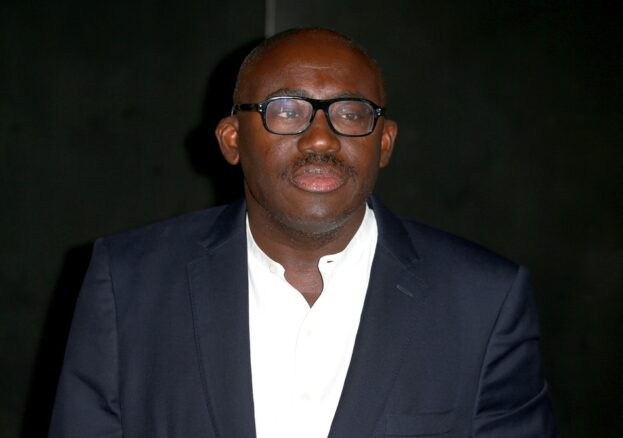
Edward Enninful’s rise to become one of the most powerful figures in global fashion is a story of vision, resilience and transformation. Born in Ghana in February 1972, the youngest of six children, he moved with his family to Ladbroke Grove in West London at the age of thirteen. His early life was shaped by contrasts: the order and discipline of his father, a former soldier, and the creativity of his mother, a skilled seamstress who made dresses for local women. In her use of fabric and flair for detail, Enninful glimpsed the possibilities of style as language—a way to tell stories without words.
London in the 1980s was not always welcoming for a young Black boy. The Enninful family faced racism and hardship, but Edward found a sense of identity through the city’s fashion and music scenes. By his teenage years he was already experimenting with clothes, learning how style could be both armour and self-expression. His path took an unexpected turn at sixteen, when he was spotted on a train by stylist Simon Foxton and invited into the world of modelling. Though he dabbled briefly in front of the camera, it was clear his future would lie behind it, shaping images rather than appearing in them.
Enninful’s break came at a remarkably young age. At just eighteen, he was appointed fashion director of i-D magazine, making him one of the youngest ever to hold such a position. His work at i-D was revolutionary. Drawing inspiration from London’s streets, clubs and diverse communities, he styled shoots that blurred the line between the catwalk and everyday life. He rejected the elitism that often defined fashion, infusing it instead with authenticity and accessibility. His vision was one where working-class kids, queer culture, and Black British style were as worthy of high-fashion pages as Paris runways.
Through the 1990s and 2000s, Enninful became one of the most sought-after stylists in the industry. He worked with American Vogue, Vogue Italia and W Magazine, shaping images that challenged the narrow standards of beauty dominating glossy pages. In 2008, he helped spearhead the legendary “Black Issue” of Vogue Italia, which featured only Black models—including Naomi Campbell, Jourdan Dunn and Alek Wek. At a time when diversity was still seen as a risk, the issue sold out worldwide and had to be reprinted—proof that audiences were hungry for the representation the industry had denied them.
Enninful’s appointment in 2017 as editor-in-chief of British Vogue marked a historic milestone. He was the first Black person and the first man to hold the role in the magazine’s century-long history. His arrival sent ripples through the fashion world, signalling that the most influential publication in British fashion was ready to look and sound different. From his very first cover—featuring Adwoa Aboah, a mixed-race model and activist—he set a new tone. The magazine would not only showcase clothes but also ideas, voices and faces that reflected modern Britain.
Under his leadership, British Vogue became both glamorous and socially engaged. He featured trailblazing figures such as Oprah Winfrey, Rihanna, and Beyoncé, but also activists, politicians, and everyday heroes. In 2020, as the COVID-19 pandemic gripped the nation, he placed NHS frontline workers on the cover, a powerful gesture that redefined what it meant to be a cover star. He also championed disability rights, trans visibility, and body diversity, ensuring that Vogue’s glossy pages told stories that resonated beyond the fashion elite.
Enninful’s influence extends far beyond the pages of any magazine. He has been honoured internationally: in 2016 he received an OBE for services to diversity in fashion, and in 2022 he published his memoir, A Visible Man, where he candidly recounted his journey through racism, homophobia and the pressures of being a pioneer in an exclusive industry. His story is not only about personal triumph but about systemic change—about how one man used his platform to reshape an entire field.
For Black History Month, Edward Enninful’s career holds particular significance. He is proof that representation at the top levels of culture changes what is possible for everyone else. By breaking through barriers at British Vogue, he showed that fashion can be more than luxury—it can be a platform for justice, pride and belonging. His success tells young Black creatives that there is a place for them in industries that once excluded them, and his legacy is one of courage and visibility
Edward Enninful’s life embodies the truth that images matter. They shape how we see ourselves and how we are seen by others. By transforming the images in the most iconic fashion magazine in Britain, he helped transform the cultural landscape itself. His legacy is not only in the covers he commissioned or the styles he championed, but in the space he made—for stories, for representation, and for possibility.

Further Reading & Sources
- Enninful, Edward. A Visible Man (memoir, 2022)
- British Vogue archives, 2017–2024 (under Edward Enninful’s editorship)
- “Edward Enninful: The Man Who Changed Vogue” — BBC Profile, 2022
- “The Making of Vogue Italia’s Black Issue” — Vogue Italia, 2008
- The Guardian and The Independent interviews with Enninful on diversity and his career
- Fashion industry coverage in Business of Fashion and Vanity Fair
